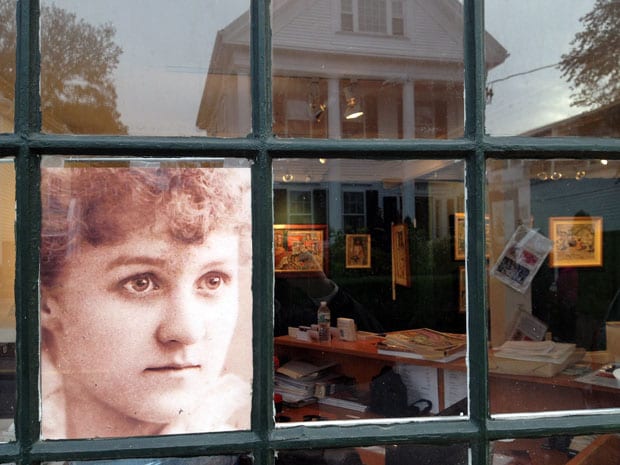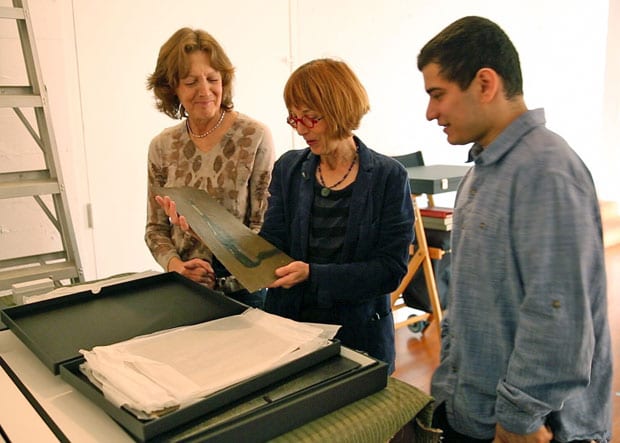Emmy-winning filmmaker Jane Anderson becomes the subject of a film: a documentary about her tragic aunt — a great artist persecuted in her time

Jane Anderson is comfortable being on a film set. A three-time Emmy Award-winner, Anderson has written some of the most acclaimed TV movies of the past 20 years, including Olive Kitteridge, The Positively True Adventures of the Alleged Texas Cheerleader-Murdering Mom, When Billie Beat Bobby, If These Walls Could Talk 2 (about lesbian relationships) and Normal (about a man who comes out as trans … a decade before Transparent). She even directed the last two, as well as the beautifully-rendered period film The Prize Winner of Defiance, Ohio.
What she was not used to was being in front of the camera. But that was a requirement of her latest project, the documentary film Packed in a Trunk: The Lost Art of Edith Lake Wilkinson, available this week on VOD and for rental. Wilkinson was an artist of great talent (but virtually no acclaim) in the early 20th century, until she was institutionalized, spending decades in an asylum, her art enjoyed only by members of her extended family … including Anderson, a niece.
When Anderson, her wife Tess and filmmaker Michelle Boyaner set out to tell Wilkinson’s story and share her sometimes rule-breaking art with a wider audience, they had no idea the project would reveal unexpected parallels between Wilkinson and Anderson’s lives … enough that it made Anderson something of a believer in the mystical connection between artists separated by a generation.
Dallas Voice: What was it like for you to go from filmmaker to subject matter? Jane Anderson: I resisted it, but Michelle was really, really good about gently urging my spouse, Tess, and I about being in the film. What she explained to us narratively was, we needed to have me in there because we didn’t want to make a straight-out factual doc about Edith — we didn’t have enough information on her. The journey has to be through me. I “got it” as a filmmaker, and my filmmaker-self told my personal-self to get over it. It was the best thing for the project. My main concern was I wanted it to be about her and not some ego-driven project on my behalf. I did get cranky once in a while.
Were you tempted to insert your own aesthetic into the filmmaking? I had that impulse, but I so trusted Michelle’s eye and [it turns out] she had much better judgment than I did. And actually, it looks like I’ll be directing a narrative film next year, and the experience of being in front of the camera should give me immense empathy for my actors.
Was there a tendency to want to perform, instead of just being you? I was able to give up the performance, mostly because I had an active job: to find out about Edith. So I just followed what I had to do. It was very emotional for me [as you can tell in the film, and] I don’t enjoy being emotional in public. When we were editing, I kept wanting to cut out the damned tears! I gave up watching myself, thanks to having a camera crew follow me around Provincetown. When you have a camera crew at your back, you come in a place with a certain authority. That’s what got everyone [involved]. If I had gone in alone, as I had back in the 1970s when I was flatly dismissed and ignored, [it might not have worked]. The documentary opened up doors for us and helped get her known. The film world has given Edith her second life.
What brought Edith to the forefront again, after all this time? I’ve had my own life to worry about so I have often shoved away [my thoughts of Edith], and she would pop up again sometimes years later. This pressing need to do something about her came up when I turned 58 — about the age she was when she went into the asylum. I do believe some of us are visited, or we hold the life of someone else inside us, who is depending on us to tell their story.
There is an unexpectedly, shall we call it, “mystical” element to the film, starting with your discovery that Edith’s partner had given her a book about Joan of Arc … the exact same book Tess would give you decades later, unaware of the history. And you even consult a medium onscreen, who proves eerily insightful. The Joan of Arc thing really just blew us away. It was just chilling. But I will say that my entire life I have felt [Edith] tapping at my shoulder. I am a pragmatist and I don’t jump to the psychic world easily, but I have felt Edith’s artistic influence and her spirit influence [all my life]. She has always been there [especially] when I have traveled abroad with my sketchbooks. As a younger woman, there was a moment I was on the African veldt on the Serengeti, looking over a flock of antelope. And at that moment, I literally thought that Edith was siting beside me, guiding my hand or celebrating that I was able to record something that she would have wanted to paint.

ART DETECTIVES | Anderson with her wife and son uncovered amazing similarities in her life with that of her aunt Edith, a gifted painter in the Fauvist tradition who was institutionalized starting in the 1920s … possibly for being gay.
Do you feel steered in your career by that mystical aspect? Does it in any way diminish your own achievements, or do you think of Edith as a kind of muse? I love questions like that… Not at all! … mainly because painting and art is a sideline for me. It’s not my career. My career is a writer-filmmaker-playwright, and it is totally my own. Honest to God, it’s a sheer delight [to be inspired by Edith]. Her color palette was a gift, but all the art I have produced is my own. I don’t feel subsumed by Edith at all, but all visual artists are influenced by other artists. I just think [of myself as having been] influenced by her work.
Edith lived fairly openly for her day, and it was interesting to see that even in the 1920s, Provincetown was a kind of gay mecca. Did making the film inform you in any way about your gay heritage? When I went to Provincetown in the 1970s, the town was very gay but the gallery owners were not. I never mentioned that narrative when I went to the museum back then, which was very stuffy. I was very shy about being [out] back then because there was still this opprobrium. It took my maturity to accept my sexuality and this wonderful long-term relationship with Tess to talk about. So by the time we did this film, I had already been out and comfortable as a gay woman for a decade — once we hit [the year] 2000, gay people became trendy!
I also have to mention: You’re famous for writing The Positively True Adventures of the Alleged Texas Cheerleader-Murdering Mom, and When Billie Beat Bobby, about Billie Jean King … both TV movies set in Texas. Do you feel your own psychic connection to the state? You know, I love the Texas culture — I love the bigness and the generosity of spirit. Molly Ivins was one of my all-time favorite writers. I think there is nothing like a strong sassy Texas woman.
This article appeared in the Dallas Voice print edition April 29, 2016.












